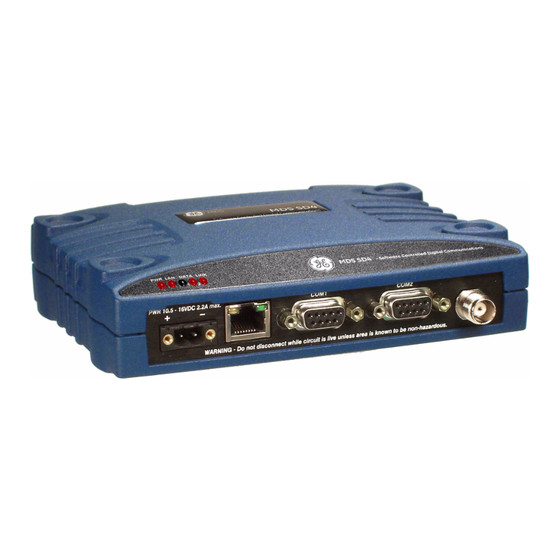
Summarization of Contents
Introduction
Conventions Used in This Manual
Explains manual conventions, notations, and features.
Electronic Manuals
Information on accessing digital copies of manuals and product bulletins.
Product Description
Front Panel Connectors and Indicators
Details the physical connectors and status LEDs on the transceiver's front panel.
Key Product Features
Highlights the main capabilities and advantages of the SD transceiver hardware.
Model Offerings
Describes the different available configurations of the SD radio models.
Operating Modes and Applicable Manuals
Explains the operating modes (x710, Packet, Transparent) and related documentation.
Accessories and Spares
Lists common accessories, spare parts, and their part numbers.
Applications
Point-to-Multipoint, Multiple Address Systems (MAS)
Describes the most common application, a central master station with remote units.
Point-to-Point System
Details the use of the transceiver for direct communication between two radios.
Continuously-Keyed versus Switched-Carrier Operation
Explains different keying behaviors for master station operation in MAS systems.
Single-Frequency (Simplex) Operation
Describes simplex operation as a special case of switched-carrier operation.
Installation Planning
Typical Installation
Shows a typical station arrangement and outlines installation steps.
Mounting Options
Covers standard flat mounting and optional DIN rail mounting for the transceiver.
Antennas and Feedlines
Discusses antenna selection and signal loss in coaxial cables for different frequencies.
DC Power Connection
Details power requirements, connection methods, and polarity for the transceiver.
Grounding Considerations
Provides guidance on safety grounding to minimize damage and ensure proper operation.
COM1 (Management) Connections
Explains how to connect a PC to the COM1 port for management and diagnostics.
COM2 (Data) Connections
Details connecting devices to the COM2 port for data transfer and supported formats.
Ethernet Interface (RJ-45)
Describes the use of the Ethernet port for radio management and its pinout.
Step-by-Step Installation
Initial Startup & Checkout
Guides on applying power, checking LEDs, and optimizing antenna alignment.
Initial Software Configuration
Steps to program the radio for its first on-air operation.
Serial vs. Telnet Access, and the Device Manager
Outlines methods for communicating with the transceiver for configuration and management.
Connecting a PC & Setting Basic Parameters
Provides instructions for connecting a PC and setting initial radio parameters.
Transceiver Management
Software Commands
Introduces software commands for transceiver configuration and operation.
Detailed Command Descriptions
Provides in-depth explanations of various commands for controlling the transceiver.
Troubleshooting
LED Indicators
Explains the function of status LEDs as a troubleshooting tool.
Event Codes
Lists and defines event codes that help diagnose system difficulties.
Technical Reference
Technical Specifications
Details frequency ranges, bandwidths, receiver sensitivity, and transmitter power.
Performing Network-Wide Remote Diagnostics
Outlines procedures for obtaining diagnostics data from remote radios.
User-Programmable I/O Functions - Pending
Notes that this section's content is pending and not yet available.
Analog Operation of the Transceiver
Provides information on using the radio for analog support and interfacing with external modems.
Upgrading the Radio's Firmware
Explains methods for installing new firmware to update radio features and performance.
In Case of Difficulty...
Technical Assistance
Provides contact information for technical support and troubleshooting assistance.
Factory Service
Outlines procedures for returning equipment for factory repair, including SRO requirements.



Need help?
Do you have a question about the SD4 and is the answer not in the manual?
Questions and answers